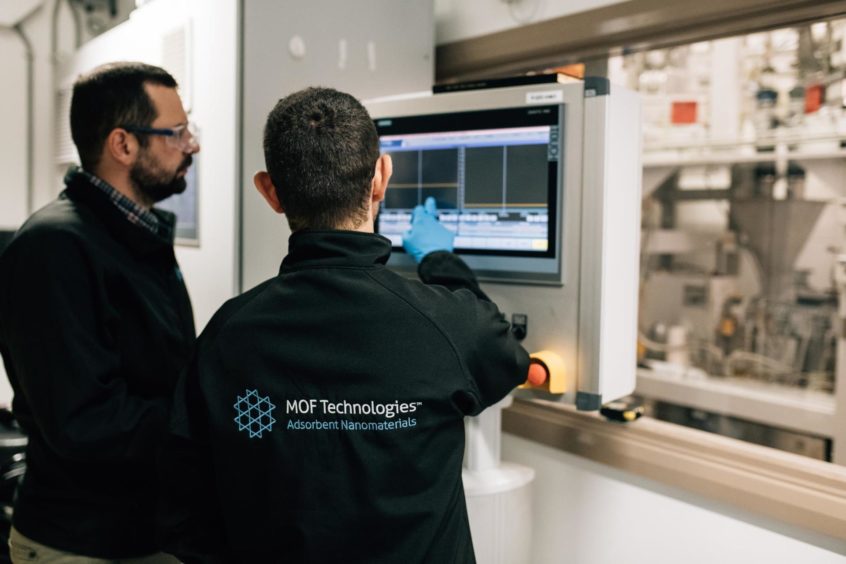
It can be difficult to imagine how science at the microscopic level is capable of making a profound impact on the world, especially when it involves new ‘wonder materials’ that are unfamiliar to us. Yet the super-adsorbing qualities of metal-organic frameworks (MOFs) look set to do just that, with many touting them as the solution to some of humanity’s most pressing challenges.
Discoveries of this kind usually come with heavy media coverage and high investment interest from businesses, often long before potential uses have been properly tested in the field. Indeed, MOFs have been studied in academic circles for decades and in some cases have already shown impressive commercial potential, but a misplaced view that they are difficult to develop has until recently stifled progress.
That’s now changing. Companies like MOF Technologies are removing these perceived barriers through an innovative end-to-end application development process that can deliver MOF-based products in a sustainable and cost-effective way. This work has unlocked MOFs’ value, with some of their applications poised to revolutionise the way we live and work.
What are MOFs?
Metal-organic frameworks are a new class of crystalline super-adsorbent. Composed of metal ions and organic linkers, they can be formed in one-, two- and three-dimensional structures and have exceptionally large surface areas. A highly porous nature often sees them likened to sponges, though unlike that material MOFs can be designed to capture, store and release specific gases. This is done through a careful selection of metals and linkers during the first stages of synthesis.
It’s this bespoke quality along with a high storage capacity that gives MOFs so much promise. Other adsorbents, like activated carbon and silica gel, cannot hold anywhere near as much medium and are unable to be used in a selective way. MOFs, on the other hand, hold up to 15 times more gas and can be developed to target everything from ethylene and ammonia to carbon dioxide and methane.
Despite these advantages, adoption has been slow. This is partly down to businesses’ unfamiliarity with MOFs as a potentially useful sorbent but also because they have often been applied by end-users with little prior experience. Availablity, production costs, formulation and performance have also proven challenging, especially for those without the right expertise.
MOF Technologies’ patented approach has now overcome these issues, being able to quickly identify, screen and scale-up MOF-based products for different commercial environments. In the post-harvest sector, for example, the business has been able to develop MOFs that store and deliver highly unstable
gases unsuitable for compression – this has helped to simplify the supply chain and help keep food fresher for longer. It has also worked with companies to create MOFs that can store up to 80% more gas when compared to other more traditional materials. It’s this end-to-end approach – the first of its kind – that’s helping MOFs move from the laboratory into the field, where their power can be harnessed by industry.
Carbon Capture
It’s not difficult to see how advances like this can be applied to some of the world’s most protracted issues, not least climate change. The 2015 Paris Agreement and the ‘net-zero by 2050’ agenda have forced countries to consider the different ways carbon emissions can be lowered over time, particularly in hard to abate industries like power generation, oil and gas and cement production. Transition to renewable energy is one solution, especially alongside the electrification of society. Carbon capture is another.
The capture of greenhouse gases will certainly be key to tackling emissions from stationary sources like coal-fired stations. However, today’s CO2 capture technologies are inhibited by high operating costs and energy intensive processes that offset any benefit to the environment. They are also hindered by low CO2 capacity and an inability to be selective about which gases are captured from a stream. MOFs can bypass these problems and offer a tailor-made solution for carbon capture. Their bespoke design give them the highest known capacity for CO2 and an unmatchable selectivity when compared to current approaches that use amine-based solvents.
MOFs are not yet commonplace across industry but that looks set to change. MOF Technologies, for example, has already engineered sorbents that can store up to half their own weight in CO2 and is also trialling different solutions across Europe to determine which iterations are able to withstand the harsh conditions found in industrial exhausts.1 Results from these studies have been favourable – this combined with a breakthrough in production suggests MOFs will become central to carbon reduction strategies in the near future.
Emerging Opportunities
Carbon capture is perhaps the most promising use for MOFs but that is only one application. Their versatile structure and ‘tunable’ properties also make them useful for the development of emerging technologies, like hydrogen fuel cells for use in zero-emission vehicles.
One aspect that has challenged the viability of hydrogen motive power is the ability to store enough gas at the correct pressure. Efforts so far have not been sufficient to support practical driving distances between refilling. However, MOFs could be the solution to this problem as they are able to hold more
gas at low pressure than expensive specialised tanks at high pressure.2 While research is still ongoing, the idea works in principle and will prove essential as many nations legislate a phasing out of petrol and diesel engines.
MOFs have also demonstrated value for harvesting water vapour from the air. One experiment saw a prototype collect over 17 litres of water per day without any added energy.3 This capability has great potential for water security in arid regions, particularly as the fluids extracted from MOF powders have been shown to be free of any contaminants.4 This approach to using MOFs has also been suggested as one way to improve indoor air quality for people living in cities.
These are just some of the areas where MOFs are set to positively disrupt society. Indeed, this discussion has not touched on other promising applications, such as MOFs for drug delivery or biological imaging and sensing. However, it’s clear these materials have a legitimate claim to the title of ‘wonder material’ and look set to benefit wherever there’s a need to extract, store or deliver something.
Dr Conor Hamill is Chief Operating Officer of MOF Technologies, a Belfast-based company spun out of Queens University.
Recommended for you

 © Supplied by MOF Technologies
© Supplied by MOF Technologies